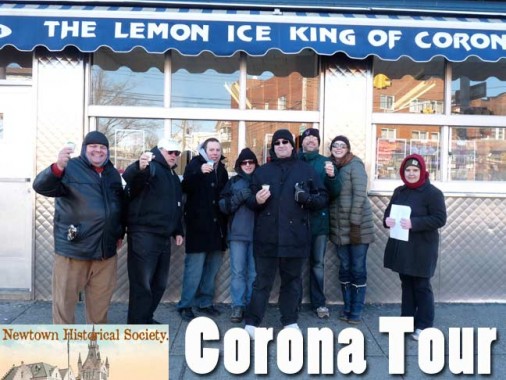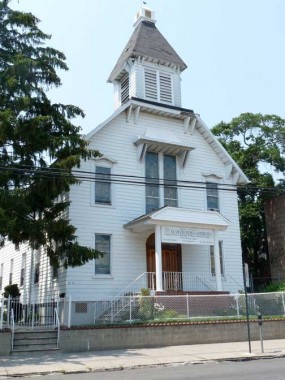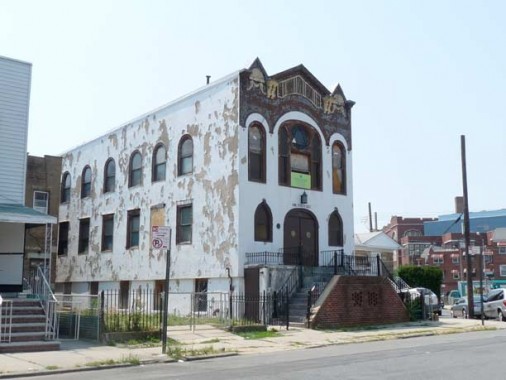Winter 2011-2012 has not been one for the frigid blasts and howling tempests that usually accompany the months of December and January as the weather has mostly been in the 40s. As luck would have it, when the Newtown Historical Society announced a march through Corona and tabbed Your Webmaster as the tour guide, the temperature hovered around 20 degrees most of the day. Yet, a hardy group of tourgoers (though a somewhat lower number than signed up!) met at Roosevelt Avenue and National Street for a brisk two-hour trip through the neighborhood just west of Flushing Meadows Corona Park, noted by everyday New Yorker, if they think of it at all, as the home of Louis Armstrong for the last 30 years of his life. And, while the NHS visited his home, now a museum in the northern part of town last winter, we decided to stalk through the South this time.
Just a few representative samples of what we visited….
The Union Evangelical Church at National and 102nd Streets was built in 1870 and was the first church in Corona. The land for the church was donated by Charles Leverich, a wealthy area landowner, who also became instrumental in the church’s success.
Sharp-eyed ForgottenFans will note some of these photos were taken during the summer. I did my scouting mission for this tour in the dead dog heat of July.
According to NYC’s Landmark Preservation Commission, “This small two-story house (c. 1871) is one of the last intact 19th century frame houses in Queens. Designed in a vernacular Italianate style, the house is notable for its decorative porch, gable and fence.” The house is on 47th Avenue between 102nd and 104th Streets and was home to poet, essayist and political writer, Edward E. Sanford (1805-1876). He was the son of U.S. Senator Nathan Sanford (1777 – 1838), who owned most of the land in the Waldheim section of Flushing, which is described on FNY’s Flushing Remnants page. Sanford Avenue in Flushing is named after the family.
Congregation Tifereth Israel of Corona, also known as the Home Street Synagogue, was added to the National Register of Historic Places in 2002. It was founded in 1911 on what is today 54th Avenue near 108th Street. Tifereth means “Glory of God.” As luck would have it, the building was completely scaffolded the day of the tour, and from the looks of things, it was in need of renovation.
Before she was known as Estée Lauder, Josephine Esther Mentzer attended this synagogue while growing up above her father’s hardware store on nearby Hillside Avenue (Van Doren Street, today). In a stable behind the house, her uncle, a chemist, mixed experimental face creams which Estée sold in Manhattan beauty salons. Over time, Estée managed to develop her one-woman cosmetics enterprise into a multi-billion dollar empire.
In 1893, Louis Comfort Tiffany and his business partner, Arthur Nash, founded the Stourbridge Glass Company in Corona next to the railroad tracks. In 1902, the name of the enterprise was changed to Tiffany Furnaces. His patented “favrile” (handmade) glass was created and manufactured here in this factory, 43rd Avenue and 97th Place. Tiffany’s works reached the height of their popularity in the years leading up to WWI and the pieces are now much sought after works of art. Business slowly declined after the war, as tastes had changed with the passage of time. In 1928, Tiffany withdrew from the company, leaving Nash’s son to run the business alone under a different name. The Great Depression brought about the end of the company. However, the factory and furnace buildings on 97th Place remain standing and are actively used today. The Queens Museum, located in nearby Flushing Meadows-Corona Park, has a permanent Tiffany collection on display, as does the Metropolitan Museum of Art in Manhattan.
Constructed by Satterlee and Boyd from 1912-1914 this firehouse, Hook & Ladder 138/Engine 289 on 43rd Avenue east of 97th Place was among the first in the city that could accommodate motorized vehicles. Inspired by French Renaissance architecture. Note the slanted mansard roof with stone dormers.
The Roman Catholic parish of St. Leo, 49th Avenue and 104th, was established in October 1903 as a mission to Italian-American residents of Corona, an area of Queens that was formerly part of the Township of Flushing. The first pastor was the Rev. John L. O’Toole, who established a flourishing Sunday-school for area children. The present building dates to 1934. The parish school, constructed in 1924 and festooned with interesting terra cotta ornamentation, is around the corner.
A 108th Street/52nd Avenue mainstay, Peter Benfaremo’s Lemon Ice King of Corona started dispensing lemon-flavored Italian ice in 1944. Today, the establishment serves either 25 or 29 varieties (depending on which of their signs you believe). Famous for their ices containing chunks of real fruit, their selection today also includes exotic flavors such as chocolate chip and peanut butter.
Did we have ice? You bet we did, and we liked it.
This modest decoration on an apartment building at 108th and Van Doren Streets is the only remaining representation in Queens of the twin symbols of the 1939 World’s Fair, a massive stylized pyramid and sphere.
Relics of the 1964-65 Fair are somewhat more numerous. Terrace on the Park is a banquet hall in Flushing Meadows–Corona Park. The building was constructed by the Port Authority of New York and New Jersey to serve as the heliport for the 1964 New York World’s Fair.It is located to the south of the New York Hall of Science. The bulk of the building is suspended in the air by four supports. It has an excellent view of New York City including the Manhattan skyline. The outside walls of the main floor are mostly accessible windows that allow guests a clear view in every direction.
That’s only a bit of what we saw. Want more? Come on the tours! The next Newtown Historical Society Tour will be announced a couple of weeks before it happens –check FNY and the NHS website linked above.
1/25/12



